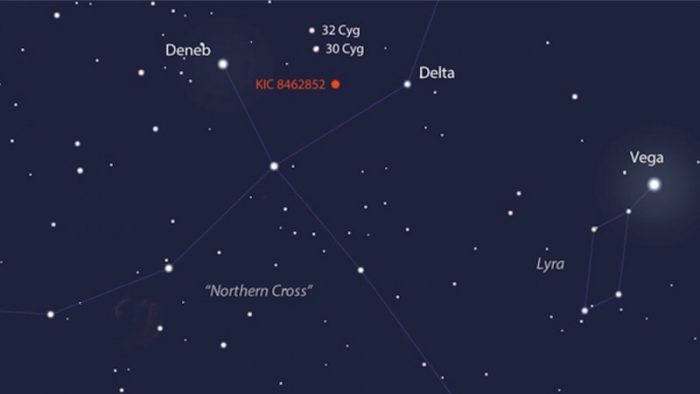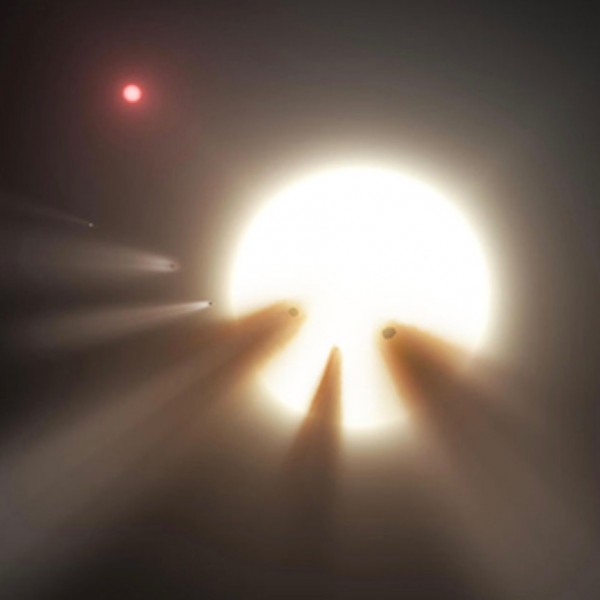
Amateur astronomer Daryll LaCourse wrote to EarthSky this week with news of a new Kickstarter campaign designed to beef up observations of KIC 8462852, also known as Tabby’s Star for its discoverer Tabetha Boyajian (and sometimes the WTF Star for “where’s the flux?”) EarthSky last presented news of this star on May 14, 2016; last we heard, astronomers were arguing over whether the star has undergone a long-term dimming on a timescale of about a century. That debate might be solved as well (more about that below), but, in the meantime, astronomers are not arguing about the downright weirdness of the observations so far of Tabby’s Star. They are still struggling to explain its strange fluctuations, first noticed in citizen scientist observations in the Planet Hunters project, using data collected by the Kepler spacecraft. Yes, the idea of alien megastructures – aka Dyson spheres – being built around this star to harvest its energy is alive and well.
LaCourse collaborates with professional astronomers on Planet Hunters, and he was second author on the discovery paper for KIC 8462852. He told EarthSky:
This object was discovered by the general public and ironically, it will now take the general public’s help to solve the mystery.
A private telescope network is needed to observe the target on a nightly basis; the AAVSO efforts are not going to be sufficient.
To that end, we (the original discovery team) have engaged in a Kickstarter campaign to secure the brand new LCOGT worldwide telescope network in order to perform a full year of observations in the hopes we can catch the star in eclipse once more. This will allow us to perform multi-color follow up observations and determine something tangible about what is blocking the star’s light.
Need we say more? Do you want to know more about this star? I know I do. Jump on over to their Kickstarter campaign, if you want to join in unraveling what is surely one of the coolest and most perplexing mysteries in astronomy today.

Daryll LaCourse also commented over the bitter argument over the possible 100-year-long dimming of this star, which got lots of publicity in mid-May. Astronomer Bradley E. Schaefer at Louisiana State University had earlier announced a brightness decrease for Tabby’s Star by 20 percent over the last century, a finding difficult to explain by natural means but consistent with the idea that aliens were gradually converting the material in the star’s planetary system into giant megastructures. Then, in May, a study led by amateur astronomer Michael Hippke announced there is no “credible evidence” for the 100-year dimming. Many media sources confused the 100-year issue with the still-earlier Kepler results, and many accepted Hippke’s new study as gospel, when of course it was just another study in what’s bound to be many, many studies. Some will naturally disagree … because that’s how science works. Daryll LaCourse told EarthSky in a private email this week that this debate:
… has not ended with the publication of the Hippke, et al … To paraphrase, Bradley Schaefer at Louisiana State University has made some new convincing arguments that their analysis is flawed, and further, a third party team appears to have used another data set to confirm his result that the star is indeed anomalously dimming over the long term (a wholly separate phenomenon from the aperiodic and anomalous transits observed by the Kepler spacecraft from 2009-2013).
Complete commentary from the LSU camp can be found here; see his point #1 and #3, specifically.
LaCourse pretty much summed it all up when he said:
Whatever is going on at Tabby’s Star, this is a big story and we are obviously dealing with at least one phenomenon not seen before by astrophysics.
So in the end, we stand to learn something very important, regardless of the outcome.
I couldn’t agree more. Now … go to Kickstarter, and let’s get some more observations of Tabby’s Star!

Bottom line: The astronomers who discovered Tabby’s Star – aka KIC 8462852 – have started a Kickstarter campaign to raise the funds needed to conduct comprehensive observations of it over the coming year. They want to unravel one of astronomy’s biggest mysteries. Is this star surrounded by an alien megastructure? Go to Kickstarter.











